lights SKODA ROOMSTER 2011 1.G Owner's Guide
[x] Cancel search | Manufacturer: SKODA, Model Year: 2011, Model line: ROOMSTER, Model: SKODA ROOMSTER 2011 1.GPages: 212, PDF Size: 3.3 MB
Page 44 of 212
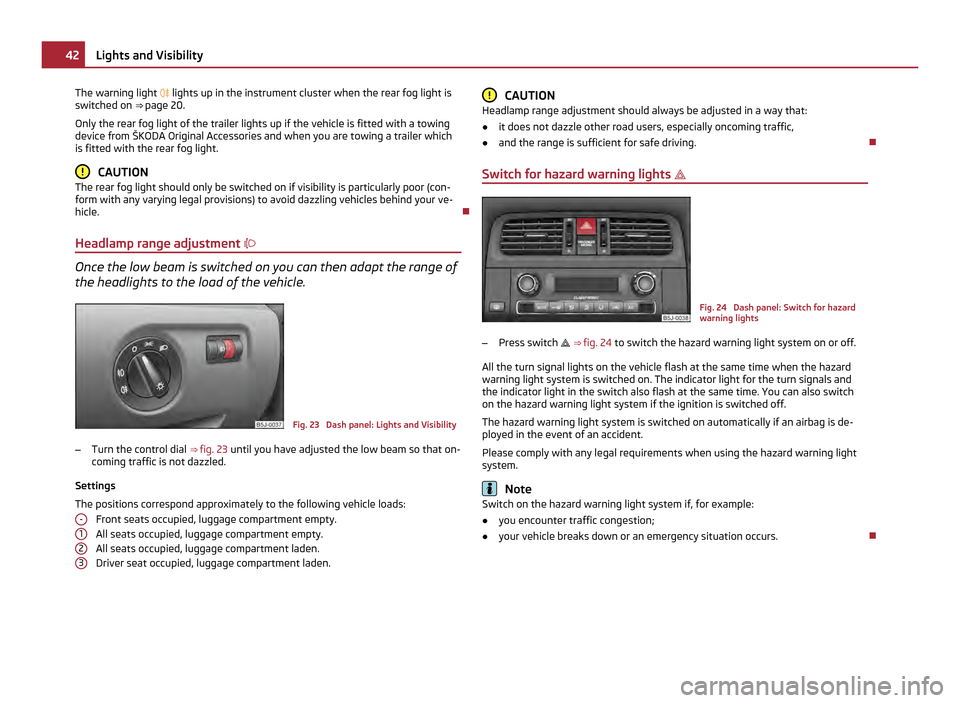
The warning light
lights up in the instrument cluster when the rear fog light is
switched on ⇒ page 20.
Only the rear fog light of the trailer lights up if the vehicle is fitted with a towing
device from ŠKODA Original Accessories and when you are towing a trailer which
is fitted with the rear fog light. CAUTION
The rear fog light should only be switched on if visibility is particularly poor (con-
form with any varying legal provisions) to avoid dazzling vehicles behind your ve-
hicle.
Headlamp range adjustment Once the low beam is switched on you can then adapt the range of
the headlights to the load of the vehicle.
Fig. 23 Dash panel: Lights and Visibility
– Turn the control dial ⇒
fig. 23 until you have adjusted the low beam so that on-
coming traffic is not dazzled.
Settings
The positions correspond approximately to the following vehicle loads: Front seats occupied, luggage compartment empty.
All seats occupied, luggage compartment empty.
All seats occupied, luggage compartment laden.
Driver seat occupied, luggage compartment laden.
- 1
2
3 CAUTION
Headlamp range adjustment should always be adjusted in a way that:
● it does not dazzle other road users, especially oncoming traffic,
● and the range is sufficient for safe driving.
Switch for hazard warning lights Fig. 24 Dash panel: Switch for hazard
warning lights
– Press switch ⇒ fig. 24 to switch the hazard warning light system on or off.
All the turn signal lights on the vehicle flash at the same time when the hazard
warning light system is switched on. The indicator light for the turn signals and
the indicator light in the switch also flash at the same time. You can also switch
on the hazard warning light system if the ignition is switched off.
The hazard warning light system is switched on automatically if an airbag is de-
ployed in the event of an accident.
Please comply with any legal requirements when using the hazard warning light
system. Note
Switch on the hazard warning light system if, for example:
● you encounter traffic congestion;
● your vehicle breaks down or an emergency situation occurs. 42
Lights and Visibility
Page 45 of 212
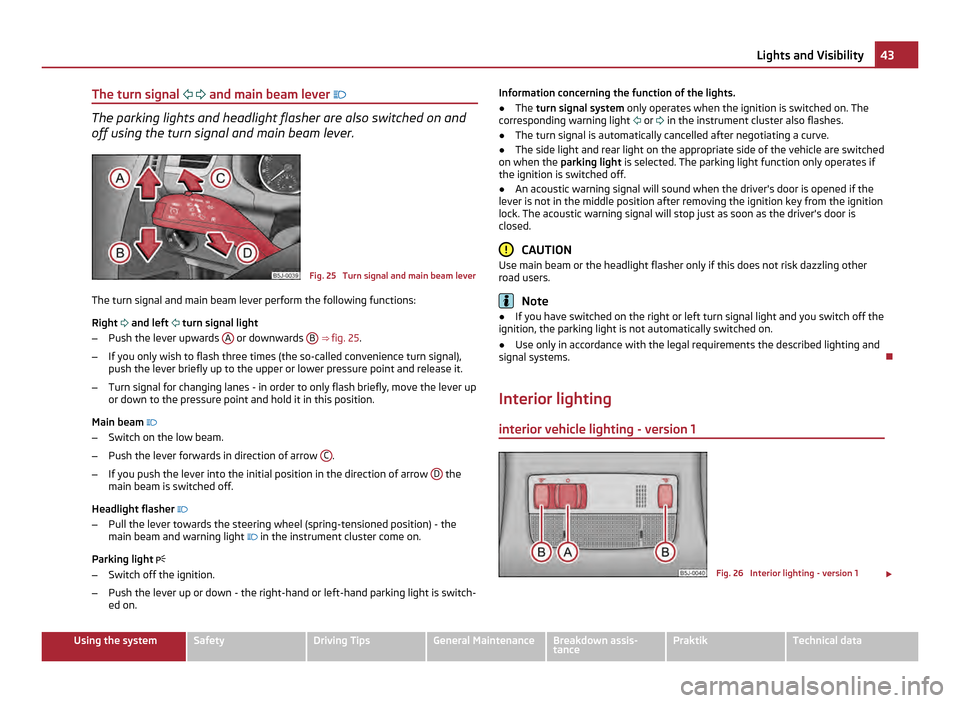
The turn signal
and main beam lever The parking lights and headlight flasher are also switched on and
off using the turn signal and main beam lever.
Fig. 25 Turn signal and main beam lever
The turn signal and main beam lever perform the following functions:
Right and left turn signal light
– Push the lever upwards A or downwards
B
⇒ fig. 25.
– If you only wish to flash three times (the so-called convenience turn signal),
push the lever briefly up to the upper or lower pressure point and release it.
– Turn signal for changing lanes - in order to only flash briefly, move the lever up
or down to the pressure point and hold it in this position.
Main beam
– Switch on the low beam.
– Push the lever forwards in direction of arrow C .
– If you push the lever into the initial position in the direction of arrow D the
main beam is switched off.
Headlight flasher
– Pull the lever towards the steering wheel (spring-tensioned position) - the
main beam and warning light in the instrument cluster come on.
Parking light
– Switch off the ignition.
– Push the lever up or down - the right-hand or left-hand parking light is switch-
ed on. Information concerning the function of the lights.
●
The turn signal system only operates when the ignition is switched on. The
corresponding warning light or in the instrument cluster also flashes.
● The turn signal is automatically cancelled after negotiating a curve.
● The side light and rear light on the appropriate side of the vehicle are switched
on when the parking light is selected. The parking light function only operates if
the ignition is switched off.
● An acoustic warning signal will sound when the driver's door is opened if the
lever is not in the middle position after removing the ignition key from the ignition
lock. The acoustic warning signal will stop just as soon as the driver's door is
closed. CAUTION
Use main beam or the headlight flasher only if this does not risk dazzling other
road users. Note
● If you have switched on the right or left turn signal light and you switch off the
ignition, the parking light is not automatically switched on.
● Use only in accordance with the legal requirements the described lighting and
signal systems.
Interior lighting interior vehicle lighting - version 1 Fig. 26 Interior lighting - version 1
£ 43
Lights and Visibility Using the system Safety Driving Tips General Maintenance Breakdown assis-
tance Praktik Technical data
Page 46 of 212
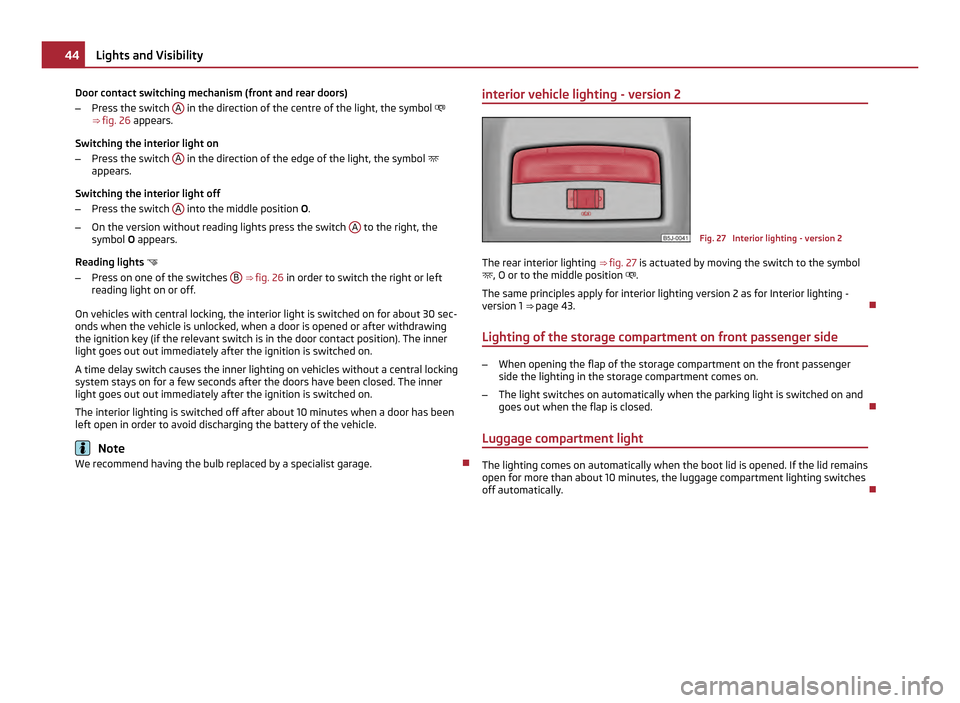
Door contact switching mechanism (front and rear doors)
– Press the switch A in the direction of the centre of the light, the symbol
⇒ fig. 26 appears.
Switching the interior light on
– Press the switch A in the direction of the edge of the light, the symbol
appears.
Switching the interior light off
– Press the switch A into the middle position
O.
– On the version without reading lights press the switch A to the right, the
symbol O appears.
Reading lights
– Press on one of the switches B
⇒ fig. 26 in order to switch the right or left
reading light on or off.
On vehicles with central locking, the interior light is switched on for about 30 sec-
onds when the vehicle is unlocked, when a door is opened or after withdrawing
the ignition key (if the relevant switch is in the door contact position). The inner
light goes out out immediately after the ignition is switched on.
A time delay switch causes the inner lighting on vehicles without a central locking
system stays on for a few seconds after the doors have been closed. The inner
light goes out out immediately after the ignition is switched on.
The interior lighting is switched off after about 10 minutes when a door has been
left open in order to avoid discharging the battery of the vehicle. Note
We recommend having the bulb replaced by a specialist garage. interior vehicle lighting - version 2 Fig. 27 Interior lighting - version 2
The rear interior lighting ⇒ fig. 27 is actuated by moving the switch to the symbol
, O or to the middle position .
The same principles apply for interior lighting version 2 as for Interior lighting -
version 1 ⇒
page 43.
Lighting of the storage compartment on front passenger side –
When opening the flap of the storage compartment on the front passenger
side the lighting in the storage compartment comes on.
– The light switches on automatically when the parking light is switched on and
goes out when the flap is closed.
Luggage compartment light The lighting comes on automatically when the boot lid is opened. If the lid remains
open for more than about 10 minutes, the luggage compartment lighting switches
off automatically.
44
Lights and Visibility
Page 47 of 212
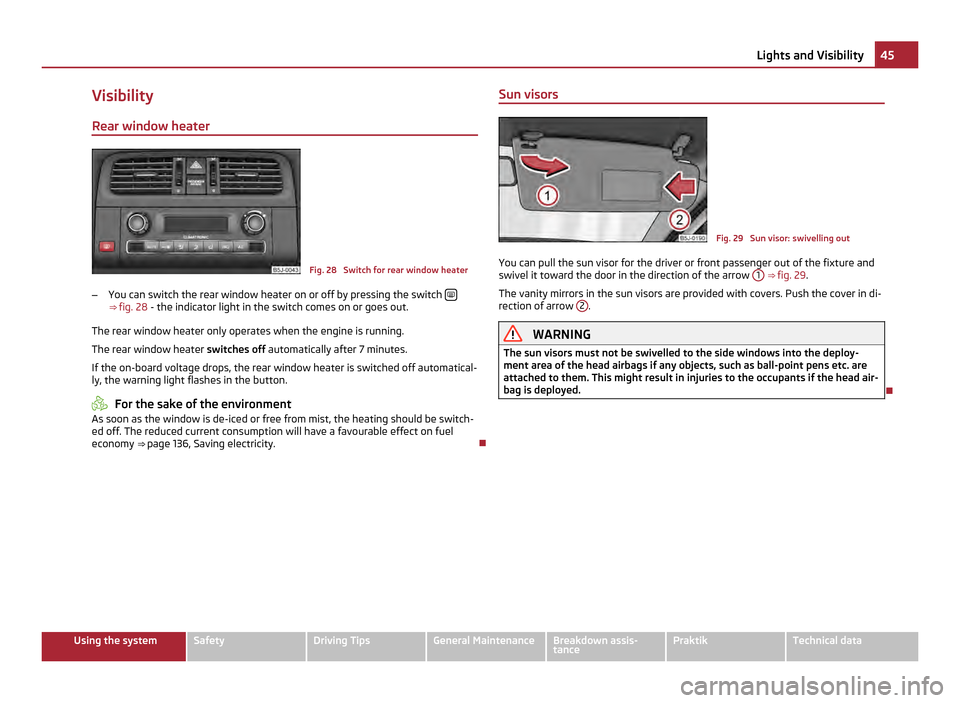
Visibility
Rear window heater Fig. 28 Switch for rear window heater
– You can switch the rear window heater on or off by pressing the switch ⇒
fig. 28 - the indicator light in the switch comes on or goes out.
The rear window heater only operates when the engine is running.
The rear window heater switches off automatically after 7 minutes.
If the on-board voltage drops, the rear window heater is switched off automatical-
ly, the warning light flashes in the button. For the sake of the environment
As soon as the window is de-iced or free from mist, the heating should be switch-
ed off. The reduced current consumption will have a favourable effect on fuel
economy ⇒ page 136, Saving electricity. Sun visors Fig. 29 Sun visor: swivelling out
You can pull the sun visor for the driver or front passenger out of the fixture and
swivel it toward the door in the direction of the arrow 1
⇒ fig. 29 .
The vanity mirrors in the sun visors are provided with covers. Push the cover in di-
rection of arrow 2 .
WARNING
The sun visors must not be swivelled to the side windows into the deploy-
ment area of the head airbags if any objects, such as ball-point pens etc. are
attached to them. This might result in injuries to the occupants if the head air-
bag is deployed. 45
Lights and Visibility Using the system Safety Driving Tips General Maintenance Breakdown assis-
tance Praktik Technical data
Page 48 of 212
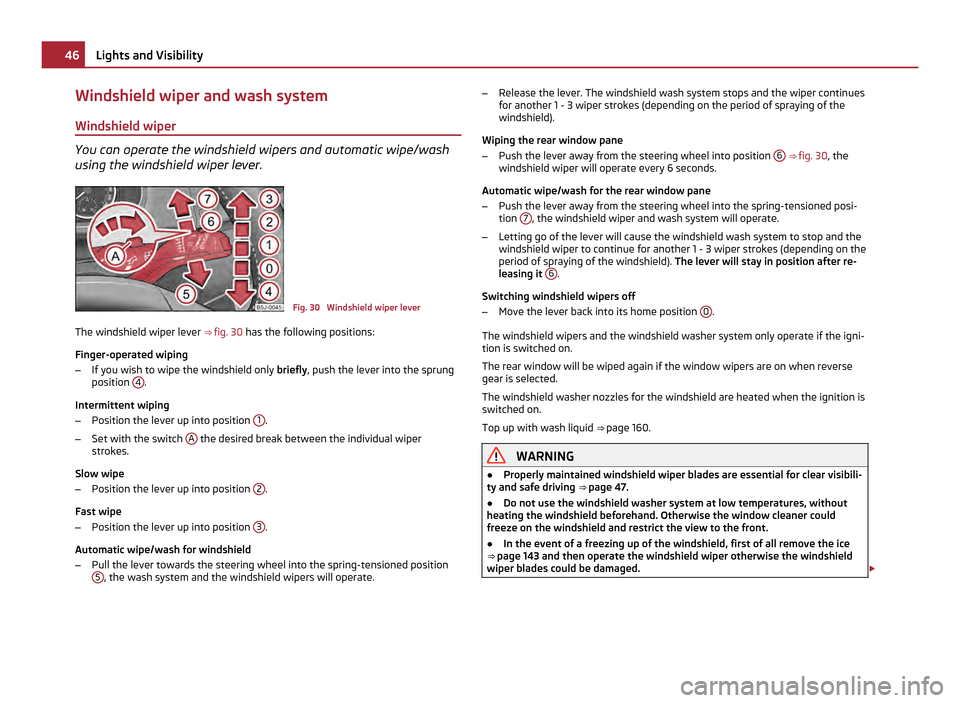
Windshield wiper and wash system
Windshield wiper You can operate the windshield wipers and automatic wipe/wash
using the windshield wiper lever.
Fig. 30 Windshield wiper lever
The windshield wiper lever ⇒ fig. 30 has the following positions:
Finger-operated wiping
– If you wish to wipe the windshield only briefly, push the lever into the sprung
position 4 .
Intermittent wiping
– Position the lever up into position 1 .
– Set with the switch A the desired break between the individual wiper
strokes.
Slow wipe
– Position the lever up into position 2 .
Fast wipe
– Position the lever up into position 3 .
Automatic wipe/wash for windshield
– Pull the lever towards the steering wheel into the spring-tensioned position
5 , the wash system and the windshield wipers will operate. –
Release the lever. The windshield wash system stops and the wiper continues
for another 1 - 3 wiper strokes (depending on the period of spraying of the
windshield).
Wiping the rear window pane
– Push the lever away from the steering wheel into position 6 ⇒ fig. 30, the
windshield wiper will operate every 6 seconds.
Automatic wipe/wash for the rear window pane
– Push the lever away from the steering wheel into the spring-tensioned posi-
tion 7 , the windshield wiper and wash system will operate.
– Letting go of the lever will cause the windshield wash system to stop and the
windshield wiper to continue for another 1 - 3 wiper strokes (depending on the
period of spraying of the windshield). The lever will stay in position after re-
leasing it 6 .
Switching windshield wipers off
– Move the lever back into its home position 0 .
The windshield wipers and the windshield washer system only operate if the igni-
tion is switched on.
The rear window will be wiped again if the window wipers are on when reverse
gear is selected.
The windshield washer nozzles for the windshield are heated when the ignition is
switched on.
Top up with wash liquid ⇒
page 160. WARNING
● Properly maintained windshield wiper blades are essential for clear visibili-
ty and safe driving ⇒
page 47.
● Do not use the windshield washer system at low temperatures, without
heating the windshield beforehand. Otherwise the window cleaner could
freeze on the windshield and restrict the view to the front.
● In the event of a freezing up of the windshield, first of all remove the ice
⇒
page 143 and then operate the windshield wiper otherwise the windshield
wiper blades could be damaged. £46
Lights and Visibility
Page 49 of 212

CAUTION
● In cold temperatures and in winter, check before the trip or before switching
on the ignition that the wiper blades are not frozen. Switching on windshield wip-
ers when the blades are frozen to the windshield may result in damage both to
the blades and the motor of the windshield wipers!
● If you switch off the ignition while the windshield wipers are on, the wipers
will sweep in the same mode the next time the ignition is switched on. At low
temperatures, the wipers may freeze to the window between switching off the ig-
nition and the next time you switch the ignition on again.
● Carefully detach frozen wiper blades from the front or rear window.
● Remove snow and ice from the window wipers before driving. Note
The content of the windshield wiper reservoir is 3.5 litres. On vehicles which are
equipped with a headlight cleaning system, the content of the reservoir is 5.4 li-
tres.
Headlight cleaning system The headlights are being cleaned after the windshield washer system has been
operated for the fifth time, the low beam or main beam are switched on as well as
the windshield wiper lever is held in the position
5
⇒
fig. 30 for about 1 second.
You should remove stubborn dirt (such as insect residues) from the headlight len-
ses at regular intervals, for example when refuelling. Please refer to the following
guidelines ⇒ page 144, The headlight lenses.
You should remove any snow from the fixtures of the washer nozzles and clear ice
in winter with a de-icing spray in order to ensure proper operation of the cleaning
system. CAUTION
Never remove the nozzles from the headlamp cleaning system by hand - risk of
damage! Replacing wiper blades for the windshield wipers Fig. 31 Wiper blade for the windshield
wiper
Removing the wiper blade
– Fold windshield wiper arm away from the windshield.
– Press the locking button, in order to unlock the wiper blade and pull off in the
direction of arrow.
Attaching the wiper blade
– Push the wiper blade until it locks up to the stop.
– Check whether the wiper blade is correctly attached.
– Fold the windshield wiper arm back onto the windshield.
Windshield wiper blades in proper condition are essential to obtain good visibility.
Wiper blades should not be allowed to become dirtied by dust, insect remains and
preserving wax.
Juddering or smearing of the wiper blades could then be due to wax residues left
on the windshield by vehicle washing in automatic vehicle wash systems. It is
therefore important to degrease the lips of the windshield wiper blades after ev-
ery pass through an automatic vehicle wash system .£ 47
Lights and Visibility Using the system Safety Driving Tips General Maintenance Breakdown assis-
tance Praktik Technical data
Page 50 of 212

WARNING
● If the windshield wipers are handled carelessly, there is a risk of damage
to the windshield.
● You should clean the wiper blades regularly with a windshield cleaner in
order to avoid any smears. Clean a wiper blade with a sponge or cloth if it is
very dirty, for example from insect residues.
● Replace the windshield wiper blades once or twice a year for safety rea-
sons. Windshield wiper blades are available at specialist garages.
Replacing the wiper blade on the rear window wiper Fig. 32 Wiper blade for the rear window
Removing the wiper blade
– Fold windshield wiper arm out from the windshield and position the wiper
blade at right angles to the wiper arm ⇒
fig. 32.
– Hold the window wiper arm at the top end with one hand.
– With the other hand unlock the locking button A in the direction of arrow and
remove the wiper blade.
Attaching the wiper blade
– Position the wiper blade onto the wiper arm and lock the locking button A .
– Check whether the wiper blade is correctly attached.
The same remarks apply here as for ⇒ page 47. Rear-view mirror
Manual dimming interior rear-view mirror Basic setting
–
Pull the lever on the bottom edge of the mirror forward.
Dimming mirror
– Pull the lever on the bottom edge of the mirror back.
Rear mirror You can adjust the exterior mirrors electrically.
Fig. 33 Inner part of door: Rotary knob
Adjust the rear mirror before commencing to drive so that there is a clear view to
the rear.
Dimming the interior mirror
– Pull the lever on the bottom edge of the mirror toward rear (the lever on the
interior mirror must point forwards in it home position).
Heating of the external mirror
– Turn the rotary knob to position ⇒
fig. 33.
Adjusting the left-hand exterior mirror
– Turn the rotary knob to position . The movement of the mirror surface is iden-
tical to the movement of the rotary knob. £48
Lights and Visibility
Page 51 of 212

Adjusting the right-hand exterior mirror
– Turn the rotary knob to position . The movement of the mirror surface is iden-
tical to the movement of the rotary knob. WARNING
● Convex (curved outward) exterior mirrors increase the field of vision. They
do, however, make objects appear smaller in the mirror. These mirrors are only
of limited use, therefore, for estimating distances to the following vehicles.
● Use whenever possible the interior rear mirror, for estimating the distan-
ces to the following vehicles. Note
● The exterior mirror heater only operates when the engine is running.
● Do not touch the surfaces of the exterior mirrors if the exterior mirror heater is
switched on.
● You can set the exterior mirrors by hand, if the power setting function fails at
any time, by pressing on the edge of the mirror surface.
● Contact your specialist garage if a fault exists with the power setting of the
exterior mirrors. 49
Lights and Visibility Using the system Safety Driving Tips General Maintenance Breakdown assis-
tance Praktik Technical data
Page 73 of 212
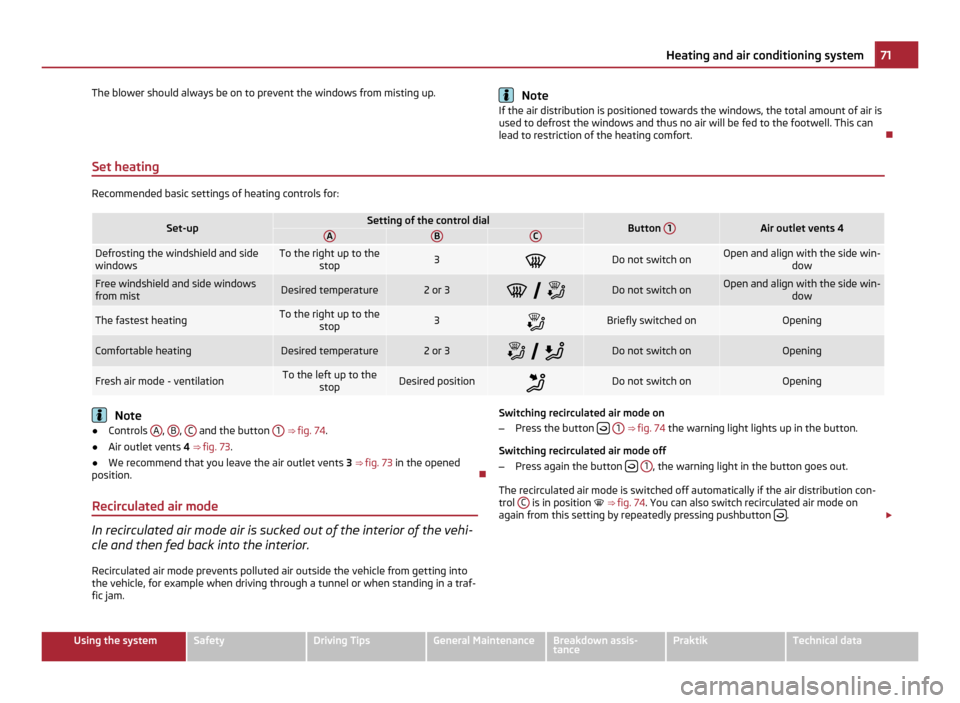
The blower should always be on to prevent the windows from misting up.
Note
If the air distribution is positioned towards the windows, the total amount of air is
used to defrost the windows and thus no air will be fed to the footwell. This can
lead to restriction of the heating comfort.
Set heating Recommended basic settings of heating controls for:
Set-up Setting of the control dial
Button
1 Air outlet vents 4
A B C
Defrosting the windshield and side
windows To the right up to the
stop 3
Do not switch on Open and align with the side win-
dowFree windshield and side windows
from mist
Desired temperature 2 or 3
Do not switch on Open and align with the side win-
dowThe fastest heating To the right up to the
stop 3
Briefly switched on Opening
Comfortable heating Desired temperature 2 or 3
Do not switch on Opening
Fresh air mode - ventilation To the left up to the
stop Desired position
Do not switch on Opening
Note
● Controls A ,
B ,
C and the button
1 ⇒ fig. 74.
● Air outlet vents 4 ⇒ fig. 73.
● We recommend that you leave the air outlet vents 3 ⇒ fig. 73 in the opened
position.
Recirculated air mode In recirculated air mode air is sucked out of the interior of the vehi-
cle and then fed back into the interior.
Recirculated air mode prevents polluted air outside the vehicle from getting into
the vehicle, for example when driving through a tunnel or when standing in a traf-
fic jam. Switching recirculated air mode on
– Press the button
1 ⇒ fig. 74 the warning light lights up in the button.
Switching recirculated air mode off
– Press again the button
1 , the warning light in the button goes out.
The recirculated air mode is switched off automatically if the air distribution con-
trol C is in position ⇒
fig. 74. You can also switch recirculated air mode on
again from this setting by repeatedly pressing pushbutton .
£ 71
Heating and air conditioning system Using the system Safety Driving Tips General Maintenance Breakdown assis-
tance Praktik Technical data
Page 74 of 212
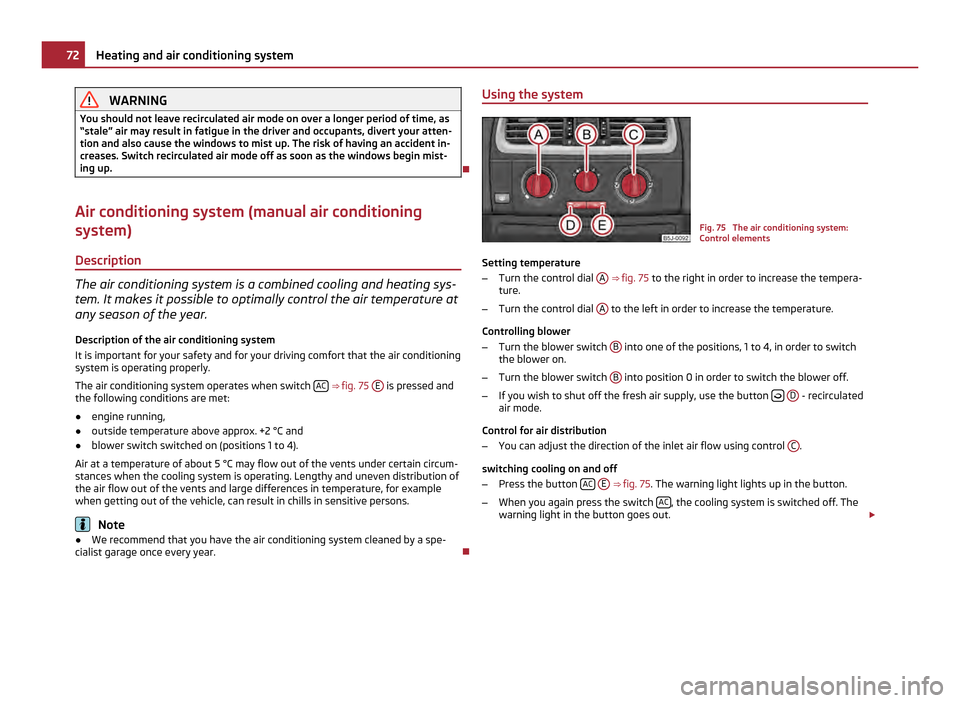
WARNING
You should not leave recirculated air mode on over a longer period of time, as
“stale ” air may result in fatigue in the driver and occupants, divert your atten-
tion and also cause the windows to mist up. The risk of having an accident in-
creases. Switch recirculated air mode off as soon as the windows begin mist-
ing up.
Air conditioning system (manual air conditioning
system) Description The air conditioning system is a combined cooling and heating sys-
tem. It makes it possible to optimally control the air temperature at
any season of the year.
Description of the air conditioning system
It is important for your safety and for your driving comfort that the air conditioning
system is operating properly.
The air conditioning system operates when switch AC
⇒ fig. 75 E is pressed and
the following conditions are met:
● engine running,
● outside temperature above approx. +2 °C and
● blower switch switched on (positions 1 to 4).
Air at a temperature of about 5 °C may flow out of the vents under certain circum-
stances when the cooling system is operating. Lengthy and uneven distribution of
the air flow out of the vents and large differences in temperature, for example
when getting out of the vehicle, can result in chills in sensitive persons. Note
● We recommend that you have the air conditioning system cleaned by a spe-
cialist garage once every year. Using the system
Fig. 75 The air conditioning system:
Control elements
Setting temperature
– Turn the control dial A
⇒
fig. 75 to the right in order to increase the tempera-
ture.
– Turn the control dial A to the left in order to increase the temperature.
Controlling blower
– Turn the blower switch B into one of the positions, 1 to 4, in order to switch
the blower on.
– Turn the blower switch B into position 0 in order to switch the blower off.
– If you wish to shut off the fresh air supply, use the button
D - recirculated
air mode.
Control for air distribution
– You can adjust the direction of the inlet air flow using control C .
switching cooling on and off
– Press the button AC
E
⇒
fig. 75. The warning light lights up in the button.
– When you again press the switch AC , the cooling system is switched off. The
warning light in the button goes out. £72
Heating and air conditioning system